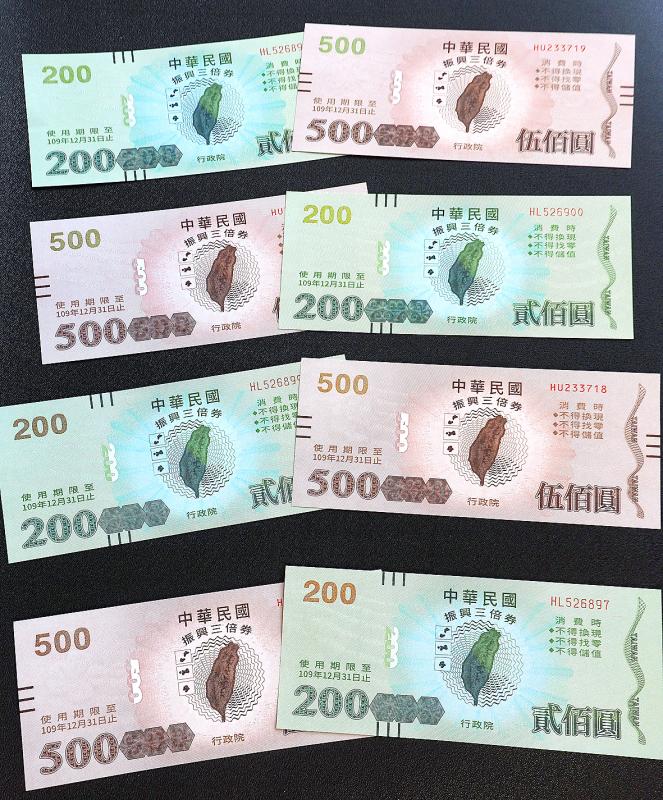A stimulus voucher program and coupon packages introduced by the Executive Yuan and other government agencies to bolster the economy have nearly tripled business revenue, the Ministry of Economic Affairs said yesterday.
Ministry officials presented the figures in a report to Premier Su Tseng-chang (蘇貞昌) at a weekly meeting of the Executive Yuan.
Su was told that the NT$65.055 billion (US$2.25 billion) spent for the Executive Yuan to issue the Triple Stimulus Vouchers and for agencies to issue coupons generated an estimated NT$179 billion in business revenue, boosting the economy amid the COVID-19 pandemic.

Photo: David Chang, EPA-EFE
The Ministry of Transportation and Communications, the Council of Agriculture, the Sports Administration, the Ministry of Culture and the Hakka Affairs Council issued their own coupons.
To boost consumer spending, people were encouraged to buy NT$3,000 of vouchers for NT$1,000.
Regardless of age or income level, all 23 million Taiwanese, as well as 150,000 foreign and Chinese spouses holding residency permits, were eligible to purchase paper or electronic vouchers.
As of Tuesday, 22.89 million people had bought the vouchers, or 96 percent of those eligible, Small and Medium Enterprise Administration Director-General Ho Chin-tsang (何晉滄) told reporters after the meeting.
About 21.09 million people selected the paper stimulus vouchers, while 1.8 million chose electronic vouchers, with only 910,000 people still needing to collect their stimulus vouchers, Ho said.
The buying spree triggered by the vouchers has been reflected in business revenue and government tax income, as seen by the growth in July retail sales, ending a five-month contraction, he said.
Taiwan’s retail sales in August and last month set historical single-month highs, as did the restaurant and beverage sector last month, Ho added.

Shares in Taiwan closed at a new high yesterday, the first trading day of the new year, as contract chipmaker Taiwan Semiconductor Manufacturing Co (TSMC, 台積電) continued to break records amid an artificial intelligence (AI) boom, dealers said. The TAIEX closed up 386.21 points, or 1.33 percent, at 29,349.81, with turnover totaling NT$648.844 billion (US$20.65 billion). “Judging from a stronger Taiwan dollar against the US dollar, I think foreign institutional investors returned from the holidays and brought funds into the local market,” Concord Securities Co (康和證券) analyst Kerry Huang (黃志祺) said. “Foreign investors just rebuilt their positions with TSMC as their top target,

REVENUE PERFORMANCE: Cloud and network products, and electronic components saw strong increases, while smart consumer electronics and computing products fell Hon Hai Precision Industry Co (鴻海精密) yesterday posted 26.51 percent quarterly growth in revenue for last quarter to NT$2.6 trillion (US$82.44 billion), the strongest on record for the period and above expectations, but the company forecast a slight revenue dip this quarter due to seasonal factors. On an annual basis, revenue last quarter grew 22.07 percent, the company said. Analysts on average estimated about NT$2.4 trillion increase. Hon Hai, which assembles servers for Nvidia Corp and iPhones for Apple Inc, is expanding its capacity in the US, adding artificial intelligence (AI) server production in Wisconsin and Texas, where it operates established campuses. This

US President Donald Trump on Friday blocked US photonics firm HieFo Corp’s US$3 million acquisition of assets in New Jersey-based aerospace and defense specialist Emcore Corp, citing national security and China-related concerns. In an order released by the White House, Trump said HieFo was “controlled by a citizen of the People’s Republic of China” and that its 2024 acquisition of Emcore’s businesses led the US president to believe that it might “take action that threatens to impair the national security of the United States.” The order did not name the person or detail Trump’s concerns. “The Transaction is hereby prohibited,”

Garment maker Makalot Industrial Co (聚陽) yesterday reported lower-than-expected fourth-quarter revenue of NT$7.93 billion (US$251.44 million), down 9.48 percent from NT$8.76 billion a year earlier. On a quarterly basis, revenue fell 10.83 percent from NT$8.89 billion, company data showed. The figure was also lower than market expectations of NT$8.05 billion, according to data compiled by Yuanta Securities Investment and Consulting Co (元大投顧), which had projected NT$8.22 billion. Makalot’s revenue this quarter would likely increase by a mid-teens percentage as the industry is entering its high season, Yuanta said. Overall, Makalot’s revenue last year totaled NT$34.43 billion, down 3.08 percent from its record NT$35.52